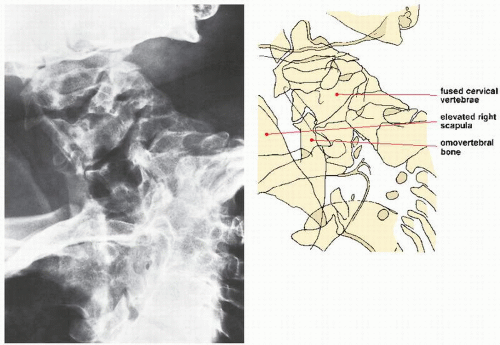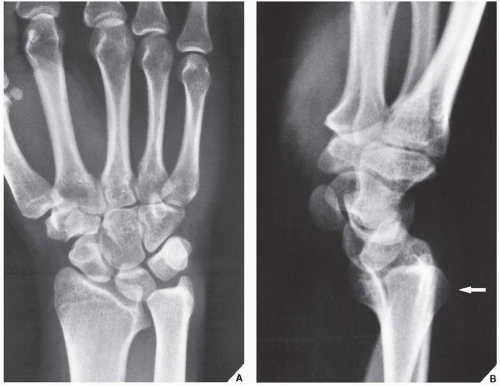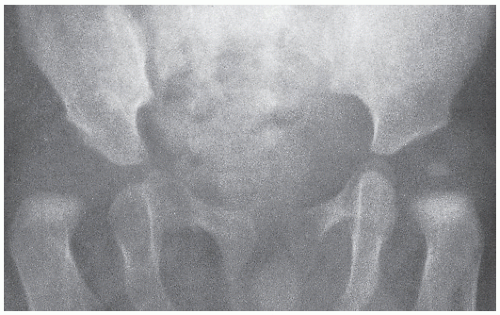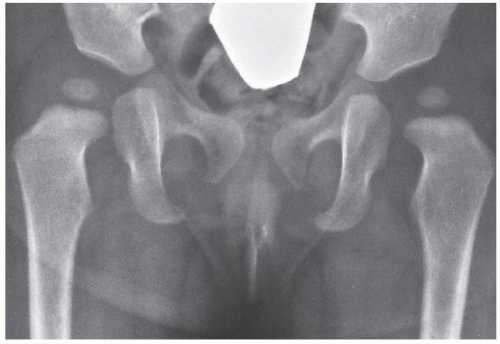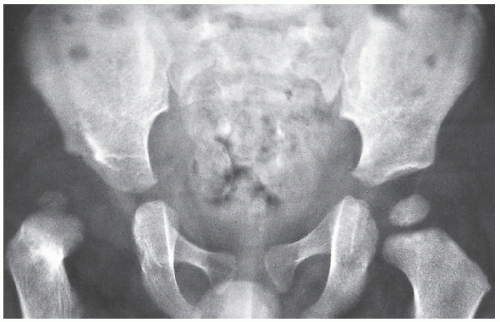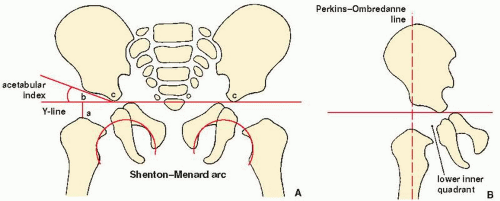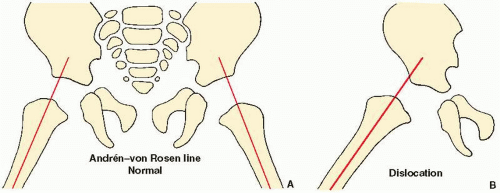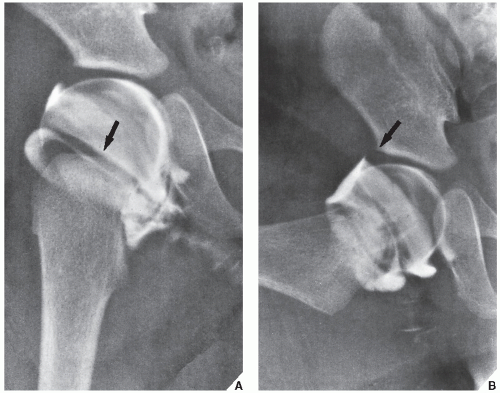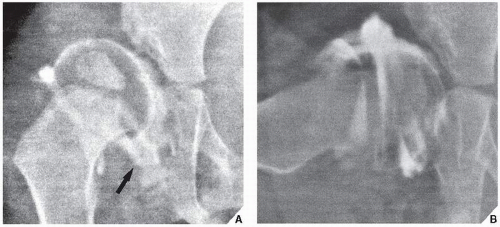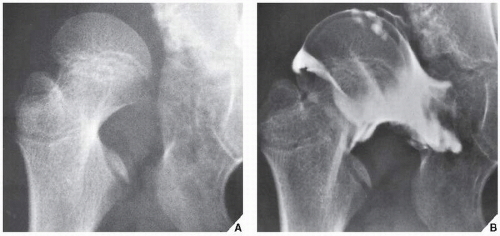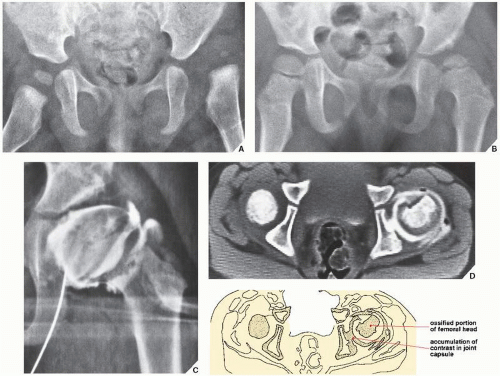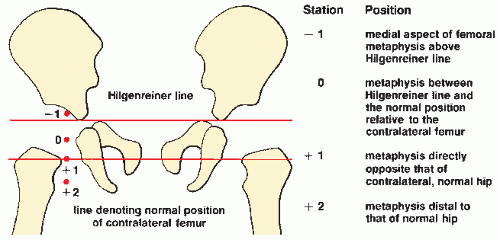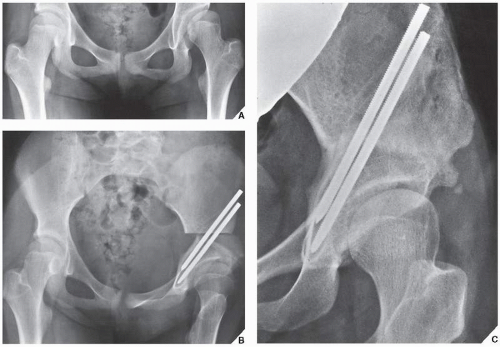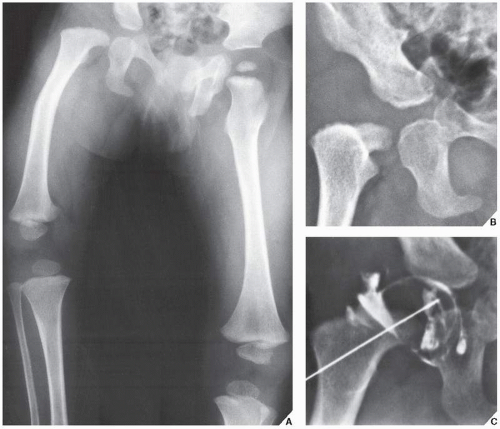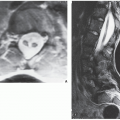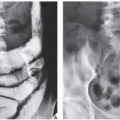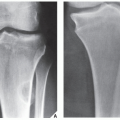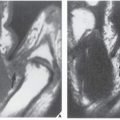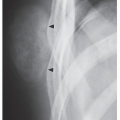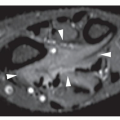presentation. The term congenital hip dysplasia, first introduced by Hilgenreiner in 1925, refers to delayed or defective development of the hip joint leading to a deranged articular relationship between an abnormal acetabulum and a deformed proximal end of the femur (Fig. 32.5). The condition is considered a precursor of subluxation and dislocation of the hip, although some authorities use the term “developmental dysplasia of the hip” (DDH) to denote all stages of CDH. In congenital subluxation of the hip, there is an abnormal relationship between the femoral head and the acetabulum, but the two are in contact (Fig. 32.6). Congenital dislocation of the hip, however, is marked by the femoral head’s complete loss of contact with the acetabular cartilage; the proximal femur is displaced most often superiorly, but lateral, posterior, and posterolateral dislocation may also be seen (Fig. 32.7).
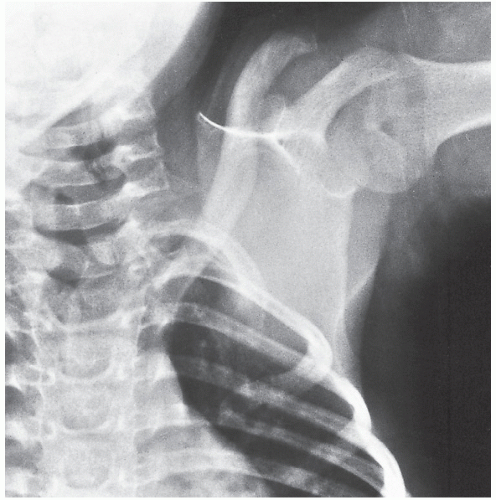 FIGURE 32.1 Sprengel deformity. Anteroposterior radiograph of the left shoulder of a 1-year-old boy demonstrates a high position of the left scapula typical of Sprengel deformity. |
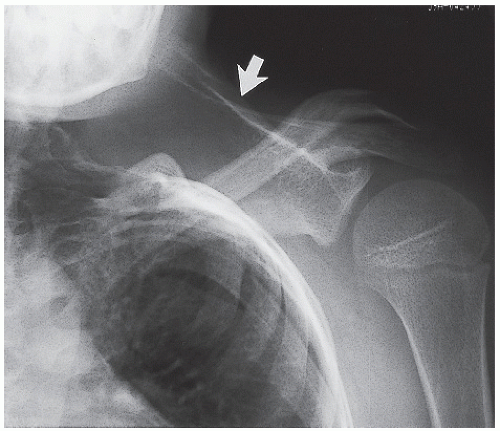 FIGURE 32.2 Klippel-Feil syndrome and Sprengel deformity. Anteroposterior radiograph of the left shoulder of a 13-year-old boy with Klippel-Feil syndrome shows an elevated scapula (arrow). |
TABLE 32.1 Radiographic Criteria for the Diagnosis of Madelung Deformity | ||||||||||||||||||||||||||||||||
|---|---|---|---|---|---|---|---|---|---|---|---|---|---|---|---|---|---|---|---|---|---|---|---|---|---|---|---|---|---|---|---|---|
| ||||||||||||||||||||||||||||||||
TABLE 32.2 Most Effective Radiographic Projections and Radiologic Techniques for Evaluating Common Anomalies of the Pelvic Girdle and Hip | ||||||||||||||||||||||||||||||||||||||||||
|---|---|---|---|---|---|---|---|---|---|---|---|---|---|---|---|---|---|---|---|---|---|---|---|---|---|---|---|---|---|---|---|---|---|---|---|---|---|---|---|---|---|---|
| ||||||||||||||||||||||||||||||||||||||||||
TABLE 32.3 Clinical Manifestations of CDH | ||||||||||
|---|---|---|---|---|---|---|---|---|---|---|
|
The Hilgenreiner line or Y-line, which is drawn through the superior part of the triradiate cartilage, is itself a valuable indicator of femoroacetabular relations and serves as the basis for all other indicators.
The acetabular index, which is an angle formed by a line tangent to the acetabular roof and the Y-line, cannot alone be diagnostic of dislocation, because it can occasionally exceed 30 degrees in normal subjects. Generally, however, values greater than 30 degrees are considered abnormal and indicate impending dislocation. Some investigators propose that only angles in excess of 40 degrees are significant.
The Perkins-Ombredanne line, which is drawn perpendicular to the Y-line through the most lateral edge of the ossified acetabular cartilage, is helpful in determining subluxation and dislocation
of the hip. The intersection of this line with the Y-line creates four quadrants; normally, the medial aspect of the femoral neck or the ossified capital femoral epiphysis falls in the lower medial quadrant.
The Shenton-Menard line, which forms a smooth arc through the medial aspect of the femoral neck and the superior border of the obturator foramen, may be interrupted in subluxation or dislocation of the hip. Even under normal circumstances, however, the arc may not be smooth if the radiograph is obtained with the hip in external rotation and adduction.
The Andrén-von Rosen line, which is drawn on a radiograph obtained with the hips abducted 45 degrees and internally rotated, describes the relation of the longitudinal axis of the femoral shaft to the acetabulum (Fig. 32.9). In dislocation or subluxation of the hip, this line bisects or falls above the anterosuperior iliac spine.
the reduction impossible. Moreover, the portion of the capsule lying medial to the femoral head is usually constricted to form an isthmus with a “figure-eight” appearance.
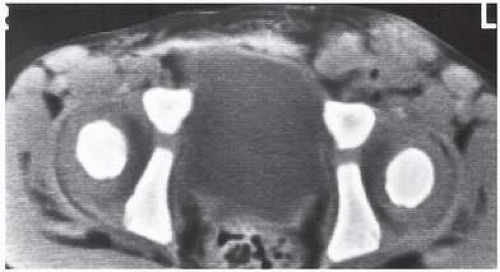 FIGURE 32.14 CT of the normal hips. Axial section of both hips in a 19-month-old infant shows good congruity of the acetabula and femoral heads, which are centered over the triradiate cartilage. |
craniocaudal (bird’s eye) view of the infant hip (Fig. 32.17). The 3D appearance of the revolving image is enhanced by the transparency of the reconstruction, in contrast to the contour reconstructions available with 3D CT.
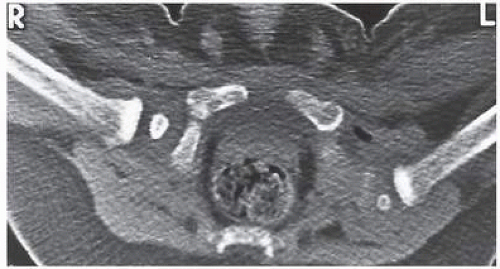 FIGURE 32.15 CT of congenital hip dislocation. Axial section through the proximal femora and hips of a 6-month-old boy shows posterolateral dislocation of the left hip. The right hip is normal. |
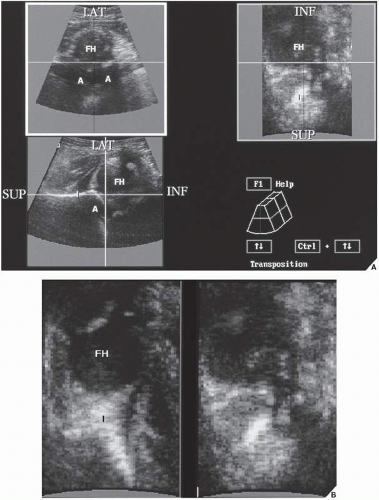 FIGURE 32.16 Ultrasound of congenital hip dysplasia. (A) On the coronal 3D ultrasound image of the left hip in a 3-day-old girl (lower left) the acetabulum (A) appears shallow, and subluxation of the femoral head can be observed at the intersection of the ilium (I) line with the medial third of the femoral head (FH). On the reconstructed axial image (upper left), the femoral head is subluxated but still in contact with the acetabulum. On the sagittal image (upper right), only the peripheral segment of femoral head is visualized. (B) A sagittal image of a normal left hip (left) is shown for comparison. Note that femoral head (FH) is centered over the ilium line (I). A sagittal image of a subluxated head (right) clearly shows distortion of femoral head-ilium line relationship. (From Gerscovich EO et al., 1994, with permission.) |
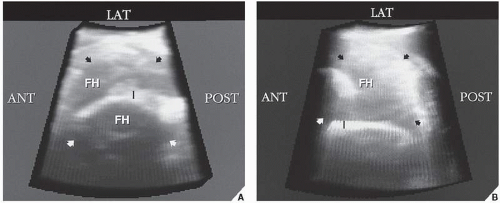 FIGURE 32.17 3D ultrasound of congenital hip dysplasia. (A) Craniocaudal projection (bird’s-eye view) of a normal left hip shows the ilium (I) projecting over the midportion of the femoral head (FH) (arrows outline its contour). (B) Craniocaudal projection of a subluxated left hip shows that the ilium (I) projects over the medial portion of the femoral head (FH) (arrows outline its contour). The femoral head is laterally displaced. (From Gerscovich EO, et al., 1994, with permission.) |
Type I | This is usually seen in neonates. The changes along the acetabular margins are mild. The femoral head, which is anteverted but spherically normal, is not completely covered by acetabular cartilage. This may lead to variable instability, particularly in extension and adduction of the hip. The labrum may also be deformed. |
Type II | The hips are subluxed, and the cartilaginous labrum shows eversion. The femoral head is normally anteverted but shows a loss of sphericity. The acetabulum is shallower than in type I, and the failure of the acetabular roof to ossify laterally leads to an increased acetabular angle. |
Type III | There is significant deformity of the acetabulum and femoral head, which is posterosuperiorly dislocated, leading to the formation of a false acetabulum by eversion of the labrum. The limbus is hypertrophied, and the ligamentum teres is elongated and pulled, bringing with it the transverse acetabular ligament. This situation compromises the acetabular space, precluding complete reduction. |
rami are performed. The acetabulum is brought forward and rotated in the frontal plane, avoiding external rotation. The Chiari pelvic osteotomy is usually reserved for older children. This is a displacement osteotomy that essentially provides a shelf or buttress to limit further proximal subluxation of the femoral head. This procedure displaces the femoral head medially and increases the weight-bearing surface of the head by producing an overhanging superior acetabular ledge. This technique may also be combined with a varus derotational osteotomy of the femoral neck. Ganz osteotomy, also known as Bernese periacetabular osteotomy, is usually performed in older children and adolescents, and occasionally in adults. The principle behind the procedure is to allow anterior and lateral rotation and medialization of the hip without violation of the posterior column of the hemipelvis. Osteotomies are performed around the acetabulum (complete osteotomy of the pubis and biplanar osteotomy of the ilium); however, the cut through the posterior column of the ischium is incomplete. The acetabular fragment is rotated anteriorly and laterally (maintaining anteversion) and is then medialized. This procedure provides excellent femoral head coverage and acetabular mobility.
Type A | The femoral head is present, and the femoral segment is short. There is a varus deformity of the femoral neck. The acetabulum is normal. |
Type B | The femoral head is present, but there is an absence of bony connection between it and the short femoral segment. The acetabulum exhibits dysplastic changes. |
Type C | The femoral head is absent or represented only by an ossicle. The femoral segment is short and tapered proximally. The acetabulum is severely dysplastic. |
Type D | The femoral head and acetabulum are absent. The femoral segment is rudimentary, and the obturator foramen is enlarged. |
technique is also helpful in distinguishing PFFD from the occasionally similar presentations of CDH.
Stay updated, free articles. Join our Telegram channel

Full access? Get Clinical Tree


